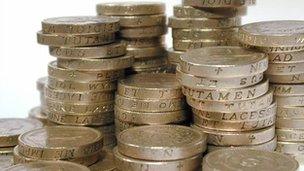How credit easing works
- Published
- comments

Loans to small businesses will be a bit cheaper due to credit easing
Here are a dozen things you need to know about credit easing, or what the government calls the National Loan Guarantee Scheme.
1) It is a government subsidy for borrowing by small businesses with turnover up to £50m.
2) Initially the Treasury will make £5bn of loans available at an interest rate one percentage point below what those businesses would typically pay to borrow.
3) At this stage therefore the best way of seeing credit easing is as a taxpayer subsidy for small business finance worth £50m a year - which, in the scale of things, is not a vast amount of money.
4) It is thought likely that the £5bn will be used up over six months. So the Treasury is expected to make available another £15bn available over the subsequent 18 months, in tranches of £5bn every six months.
5) A quintet of banks will participate initially. They are Royal Bank of Scotland (mainly its NatWest arm), Lloyds, Barclays, Santander and the new specialist lender, Aldermore.
6) The way the scheme works is that the Treasury will guarantee borrowing by the banks. This will allow the banks to borrow more cheaply than they normally do, for maturities of three years and five years. The banks then have to pass on the benefit of this cheaper funding in the form of lower interest rates for small business borrowers.
7) Banks have to pay a fee of circa 0.3% (what's known as 30 basis points) to the Treasury for the state guarantee, to get round European Union prohibitions on state aid for business.
8) HSBC is not participating in the scheme because it is able to raise funds much more cheaply than the other banks (it is perceived by investors and creditors to be the strongest of the banks). Its cost of borrowing is quite close to the government's cost of borrowing. So taking the guarantee from the Treasury would reduce HSBC's borrowing costs only slightly. Which means that it would lose money on lending to small businesses after paying the fee to the Treasury for the guarantee and after the administration costs of the scheme.
9) RBS will be the biggest user of the scheme because it has the biggest share of UK small business banking, and its borrowing costs are relatively high. It is expected to provide around a third or £1.5bn of the initial batch of cheaper loans and will direct this finance towards businesses at the smaller end of the spectrum (with turnover up to £5m). RBS will provide loans as small as £1000 under the scheme.
10) The Treasury is not forcing the banks to take greater risks when lending to businesses. So there is no reason to assume that the total volume of lending to small businesses will increase much as a result of the scheme.
11) The volume of lending to smaller businesses could increase, if all the publicity and hoo-ha around credit easing - and the cut in the cost of the debt - were to encourage businesses to request more and bigger loans.
12) There is a big paradox around credit easing, which some will find amusing and some will find painful. The thrust of most of the Treasury big policies towards the banks is to reduce the implicit taxpayer subsidy for them, through regulations and structural reforms that reduce the need for taxpayers to bail them out in a crisis. However credit easing is all about introducing an explicit subsidy for one central element in banks' activities.